I don't know how it feels for you, but for me, commuting to the office is a 65km long frustration. Every morning, on the A1 between Genève and Lausanne, I drive past eight radar detectors. Every Wagnerian ride is interrupted by the Helvetian traffic control cameras.
This is the paradox of the current road system and even of the system overall. We are able to reach speeds higher than ever, but this capacity is completely void because of the law enforcement. Cars are more powerful than tanks; they carry more electronics than an IBM supercomputer and rely on more security systems than an airliner. In short, we have never been as fast, as strong and as safe. Unfortunately, the roadsides are filled with repressive devices....
The morale is that one can't enjoy speeding on the road anymore! Speed, this shameful practice, hated, banned from our roads, when it contributed so much to our development; Well, at TAG Heuer's, one is still fond of it. Certainly, at TAG Heuer's, one fancies its horologic version, but in its purest form: Always faster, always stronger.
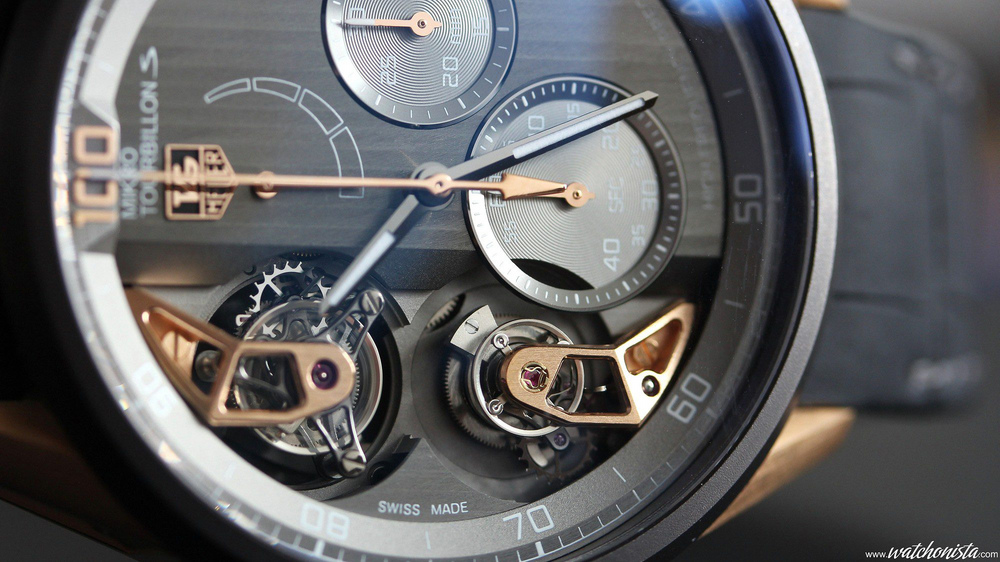
TAG has been leading the "chase for high frequencies" for some time. Originally, the goal of this series of developments was to produce a COSC certified chronograph. Yet, to avoid perturbations, it takes two regulating organs: a classic balance set at 28,800v/h and a very high frequency regulating organ for the chronometer. You will notice that I intentionally avoid the term "balance" for the chronograph's very high frequency regulating organ; why?
Because Guy Sémon, the head of TAG's development department, soon had to deal with the balance's physical limitations, during the construction of the Mikrotimer at 1/1000th of a second. If the Mikrograph, accurate up to 1/100th of a second, works very well with relatively classic balance and a hairspring, the Mikrotimer at 1/1000th does not use a balance anymore and its very specific hairspring is mounted directly on the shank... It was very difficult task; with only 11 copies produced, it is already a collector's piece.
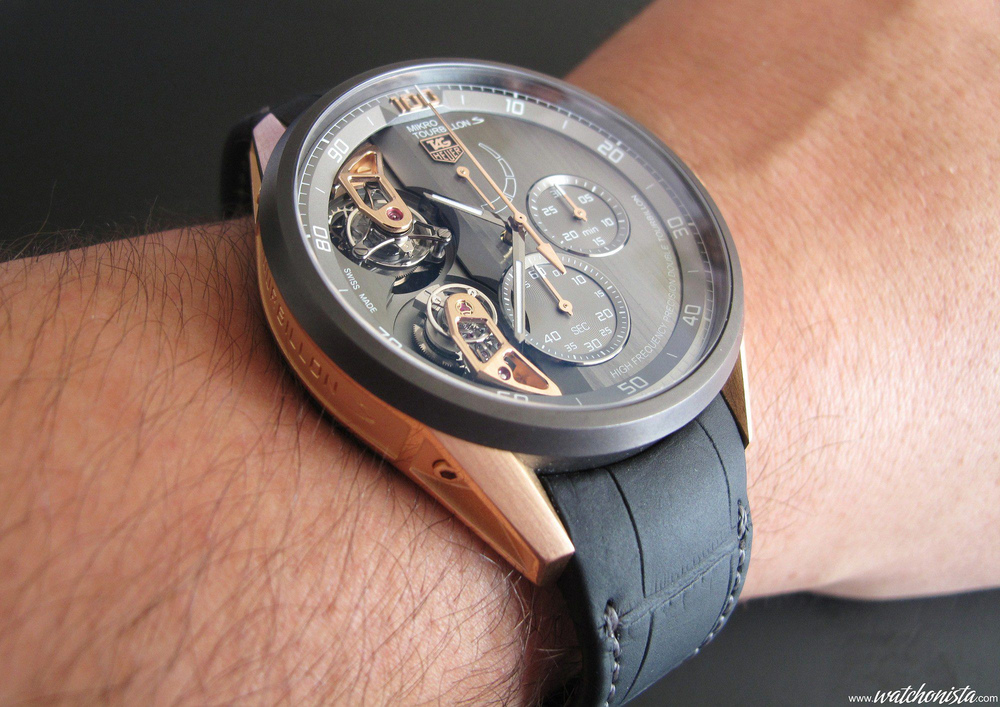
The development team had to re-invent the wheel (flat!) to exceed the hairspring's physical limitations. They are currently produced by actuator-powered rolling mills, but even this cutting-edge technology is reaching its limits.
The possible deviation in the hairsprings' width is 0.1 micrometer, which leads to an average variation of about 0.99 second per day, at best (so, "mass market" calibers are generally quite accurate). As a consequence, one quickly reaches the classic hairspring chronometric limitations. As the time intervals get shorter, the frequency increases proportionally and the window during which the timing remains accurate diminishes accordingly. At 1/1000th of a second, the timing is accurate only within a one minute window, when the timing of 1/10th of a second gap remains accurate for 100 minutes. It means that the "chronographing" windows make no sense beyond two hours, with a 4Hz frequency, without taking into account the power losses and the other interferences.
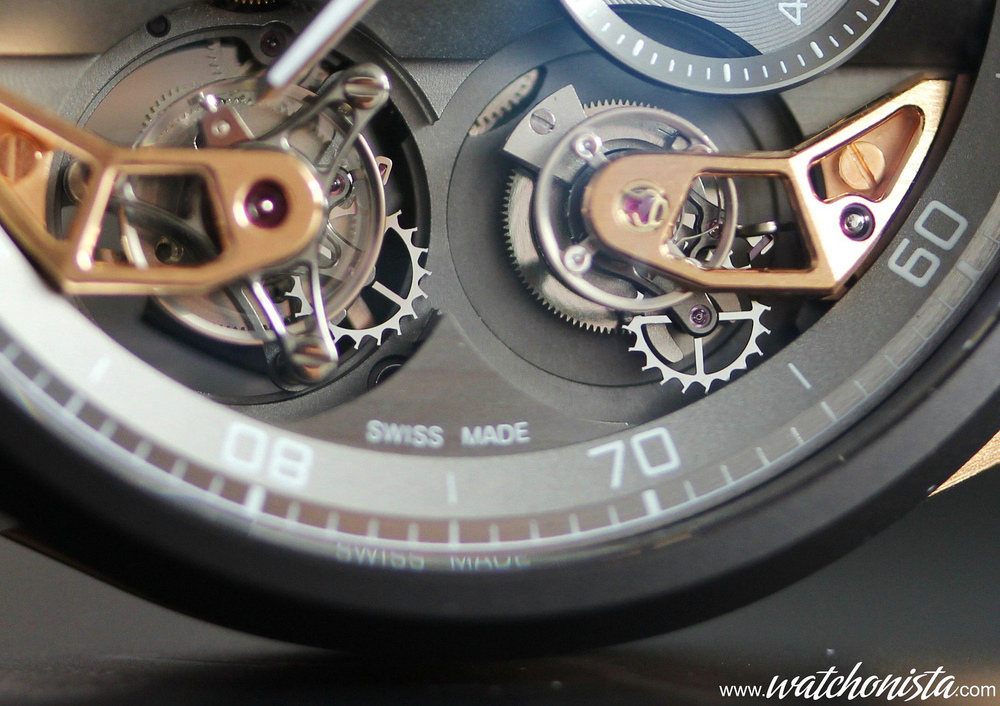
Thus, to produce a chronograph watch complying with the COSC criteria, even when the chronograph is engaged, it takes two independent power chains (or, if one wants to be more purist-than-a-purist, it takes a single power chain with a torque regulating system). And if one wishes to produce a chronograph more accurate than 1/1000th of a second, one has to come up with a specific design. It has been done with the Mikrogirder, whose oscillating "beams" system (inspired by Huygens, like the hairspring)) allows measurements accurate beyond 1/1000th of a second. When the frequency is too high for a hairspring to work properly, the linear regulating organ resonates and generates a precise rhythm.
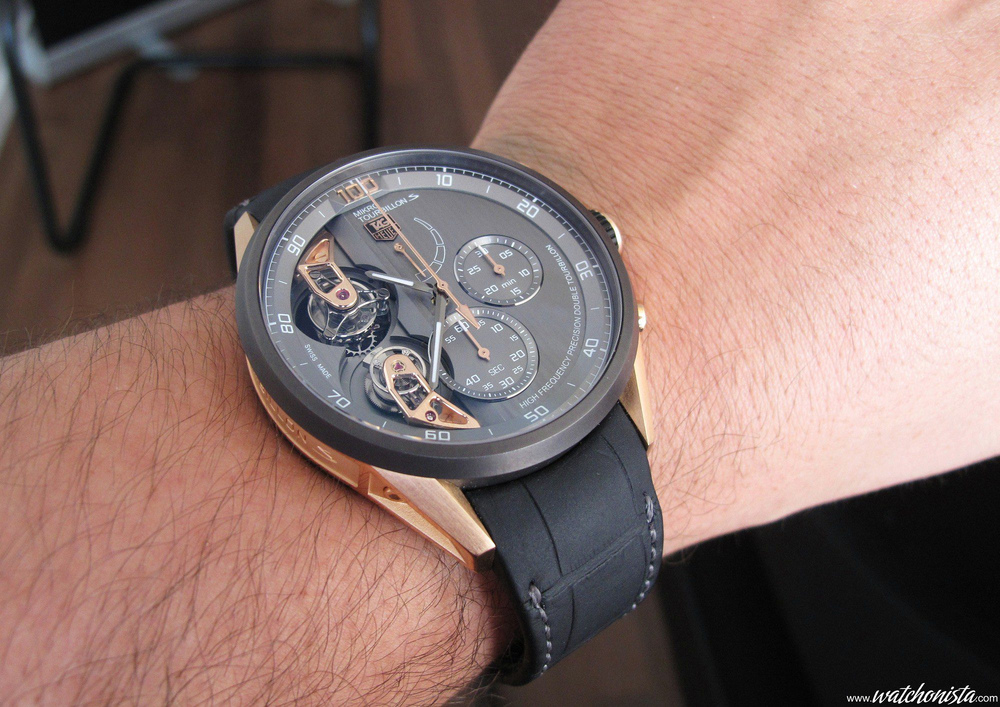
Between the three high frequency chronographs, Mikrograph, Mikrotimer and Mikrogirder, I have to say that I prefer the slowest, the Mikrograph at 1/100th of a second (remember, we had the opportunity to take pictures of the piece presented at only watch)
Like the low frequency flying seconds (14,400 or 18,000v/h), the balletic movement of a very fast hand is never more beautiful than when it can still be caught by a human eye.
If the movement of the Microtimer is barely observable, the Mikrogirder's is totally invisible: the only indication that the chronograph is working is a loud humming.
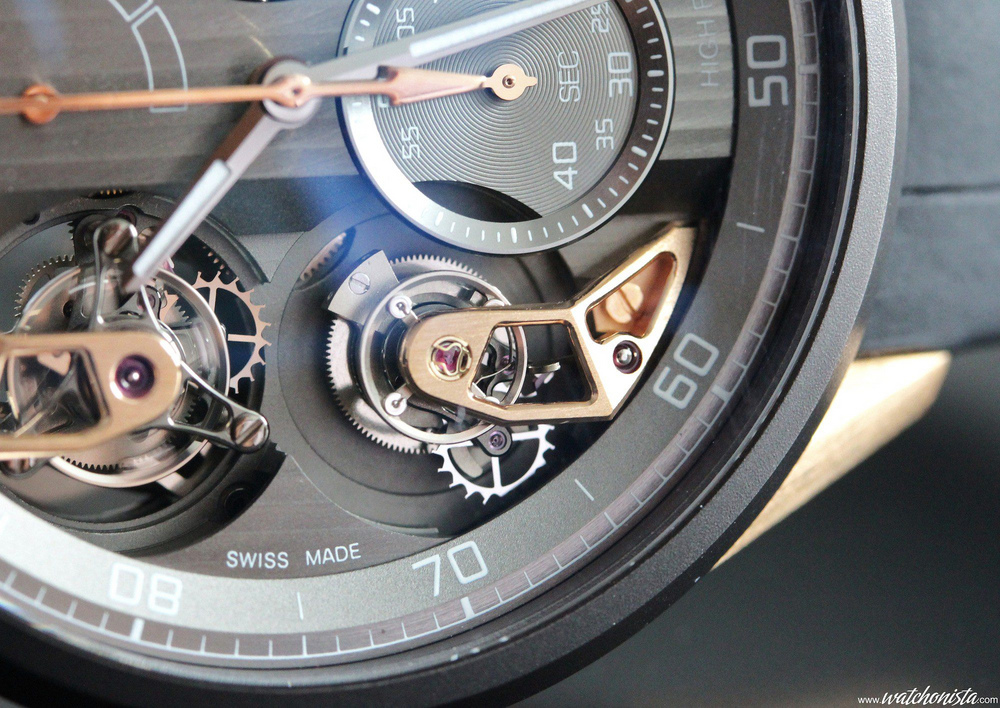
Now the MikrotourbillonS comes timely. It is the newborn of the series. As its name suggests, it involves tourbillons.
It is an interesting turning point in the series: until now, the motto was "always faster, always stronger".
Notwithstanding the important innovations regarding the regulating organ, it was purely "quantitative", because it only pushed further the envelope of the measurable interval by a mechanical chronograph. Today, the innovation is more quality oriented, as it combines the most old fashioned watchmaking (and the most necessary), namely the tourbillon, with the high frequency escapement devices from TAG Heuer.
The watch features a classic 1 minute tourbillon associated with an also classic escapement 4Hz device, with a 45-hour power reserve; thanks to the quality of its construction, it is COSC certified.
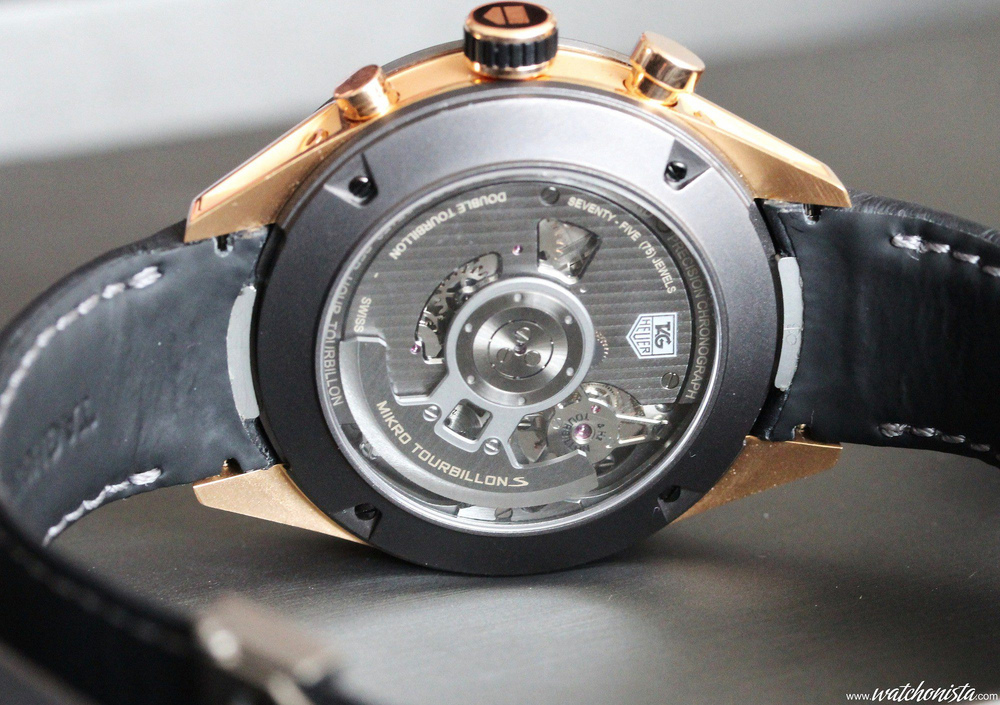
On the contrary, the chronograph escapement is exceptional in all respects. It is one of the few tourbillons with a split-second, an essential feature because of the short power reserve (60-minute) consistent with its 50Hz frequency.
The tourbillon not only features a stopping system, but it revolves 12 times per minute, astounding! This entire escapement device drives the large second hand at 1/100th, which completes one rotation per second.
Finally, it is COSC certified, which is not unique for a tourbillon, but extremely rare, like the presence of the stopping device. When it is still, the MikrotourbillonS is almost placid, with the balletic movement of the 1 minute tourbillon; but when the chronograph is set off, it is explosive! The tourbillon's escapement turns crazy, the large second hand flies like a missile; it is an absolutely mesmerizing sight.

After a few years of horologic blogging, one is almost bored, one believes to have seen it all, and one assumes that watchmaking has nothing left that could still shake us. But here, it is objectively the biggest slap I received from a chronograph, since the presentation of the Jaeger LeCoultre "platinum Duomètre". It actually is a far stronger slap: I had seen very impressive tourbillons, like "Histoire de Tourbillon 3", presented a few months ago, as well as super-fast chronometers, like the TAG Mikros series. But such a combo exceeds my craziest dreams, as it is so amazing! As shown in this video:
http://www.youtube.com/watch?v=D4VxTL-8USc
Aesthetically, the watch features TAG Heuer's typical codes, the rose gold and tantalum 45mm case is very nicely executed, and the contrast between the metals is consistent with the association between the classic tourbillon and the high frequency. But the lugs are a bit too long, which is surprising, as the watch is already of a decent size.
Regarding the dial, it is the same contrast: the recessed beveling that leads to the two tourbillons is quite original and allows distinguishing in an elegant manner between the côtes de Genève and the super-modern tourbillon's bridges.
The bezel (graduated from 1 to 100) would have benefited from being as well integrated as the sub-dials...
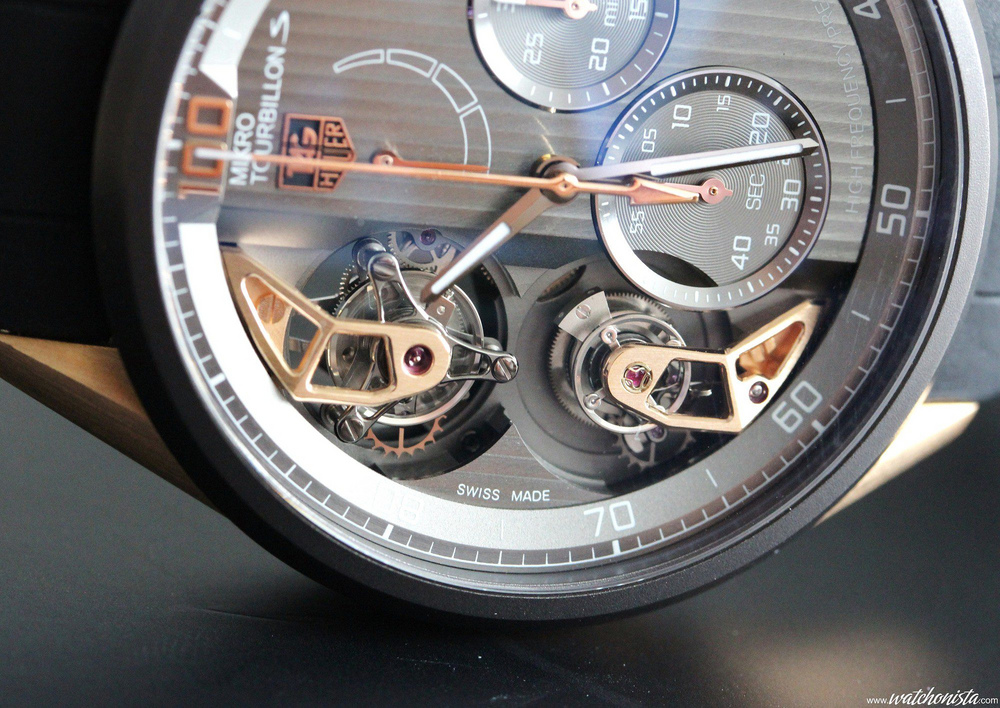
On the wrist, the watch is relatively discreet considering the mechanical complexity of the supersonic machine; without being a super-flat from a classic brand, it is not as show-off as the creations of certain independents.
So much the better, it is a very Great complication that one can wear casually, as would a young enthusiast having just purchased his first fine watch, very often a TAG...
This is the paradox of the current road system and even of the system overall. We are able to reach speeds higher than ever, but this capacity is completely void because of the law enforcement. Cars are more powerful than tanks; they carry more electronics than an IBM supercomputer and rely on more security systems than an airliner. In short, we have never been as fast, as strong and as safe. Unfortunately, the roadsides are filled with repressive devices....
The morale is that one can't enjoy speeding on the road anymore! Speed, this shameful practice, hated, banned from our roads, when it contributed so much to our development; Well, at TAG Heuer's, one is still fond of it. Certainly, at TAG Heuer's, one fancies its horologic version, but in its purest form: Always faster, always stronger.

TAG has been leading the "chase for high frequencies" for some time. Originally, the goal of this series of developments was to produce a COSC certified chronograph. Yet, to avoid perturbations, it takes two regulating organs: a classic balance set at 28,800v/h and a very high frequency regulating organ for the chronometer. You will notice that I intentionally avoid the term "balance" for the chronograph's very high frequency regulating organ; why?
Because Guy Sémon, the head of TAG's development department, soon had to deal with the balance's physical limitations, during the construction of the Mikrotimer at 1/1000th of a second. If the Mikrograph, accurate up to 1/100th of a second, works very well with relatively classic balance and a hairspring, the Mikrotimer at 1/1000th does not use a balance anymore and its very specific hairspring is mounted directly on the shank... It was very difficult task; with only 11 copies produced, it is already a collector's piece.

The development team had to re-invent the wheel (flat!) to exceed the hairspring's physical limitations. They are currently produced by actuator-powered rolling mills, but even this cutting-edge technology is reaching its limits.
The possible deviation in the hairsprings' width is 0.1 micrometer, which leads to an average variation of about 0.99 second per day, at best (so, "mass market" calibers are generally quite accurate). As a consequence, one quickly reaches the classic hairspring chronometric limitations. As the time intervals get shorter, the frequency increases proportionally and the window during which the timing remains accurate diminishes accordingly. At 1/1000th of a second, the timing is accurate only within a one minute window, when the timing of 1/10th of a second gap remains accurate for 100 minutes. It means that the "chronographing" windows make no sense beyond two hours, with a 4Hz frequency, without taking into account the power losses and the other interferences.

Thus, to produce a chronograph watch complying with the COSC criteria, even when the chronograph is engaged, it takes two independent power chains (or, if one wants to be more purist-than-a-purist, it takes a single power chain with a torque regulating system). And if one wishes to produce a chronograph more accurate than 1/1000th of a second, one has to come up with a specific design. It has been done with the Mikrogirder, whose oscillating "beams" system (inspired by Huygens, like the hairspring)) allows measurements accurate beyond 1/1000th of a second. When the frequency is too high for a hairspring to work properly, the linear regulating organ resonates and generates a precise rhythm.

Between the three high frequency chronographs, Mikrograph, Mikrotimer and Mikrogirder, I have to say that I prefer the slowest, the Mikrograph at 1/100th of a second (remember, we had the opportunity to take pictures of the piece presented at only watch)
Like the low frequency flying seconds (14,400 or 18,000v/h), the balletic movement of a very fast hand is never more beautiful than when it can still be caught by a human eye.
If the movement of the Microtimer is barely observable, the Mikrogirder's is totally invisible: the only indication that the chronograph is working is a loud humming.

Now the MikrotourbillonS comes timely. It is the newborn of the series. As its name suggests, it involves tourbillons.
It is an interesting turning point in the series: until now, the motto was "always faster, always stronger".
Notwithstanding the important innovations regarding the regulating organ, it was purely "quantitative", because it only pushed further the envelope of the measurable interval by a mechanical chronograph. Today, the innovation is more quality oriented, as it combines the most old fashioned watchmaking (and the most necessary), namely the tourbillon, with the high frequency escapement devices from TAG Heuer.
The watch features a classic 1 minute tourbillon associated with an also classic escapement 4Hz device, with a 45-hour power reserve; thanks to the quality of its construction, it is COSC certified.

On the contrary, the chronograph escapement is exceptional in all respects. It is one of the few tourbillons with a split-second, an essential feature because of the short power reserve (60-minute) consistent with its 50Hz frequency.
The tourbillon not only features a stopping system, but it revolves 12 times per minute, astounding! This entire escapement device drives the large second hand at 1/100th, which completes one rotation per second.
Finally, it is COSC certified, which is not unique for a tourbillon, but extremely rare, like the presence of the stopping device. When it is still, the MikrotourbillonS is almost placid, with the balletic movement of the 1 minute tourbillon; but when the chronograph is set off, it is explosive! The tourbillon's escapement turns crazy, the large second hand flies like a missile; it is an absolutely mesmerizing sight.

After a few years of horologic blogging, one is almost bored, one believes to have seen it all, and one assumes that watchmaking has nothing left that could still shake us. But here, it is objectively the biggest slap I received from a chronograph, since the presentation of the Jaeger LeCoultre "platinum Duomètre". It actually is a far stronger slap: I had seen very impressive tourbillons, like "Histoire de Tourbillon 3", presented a few months ago, as well as super-fast chronometers, like the TAG Mikros series. But such a combo exceeds my craziest dreams, as it is so amazing! As shown in this video:
http://www.youtube.com/watch?v=D4VxTL-8USc
Aesthetically, the watch features TAG Heuer's typical codes, the rose gold and tantalum 45mm case is very nicely executed, and the contrast between the metals is consistent with the association between the classic tourbillon and the high frequency. But the lugs are a bit too long, which is surprising, as the watch is already of a decent size.
Regarding the dial, it is the same contrast: the recessed beveling that leads to the two tourbillons is quite original and allows distinguishing in an elegant manner between the côtes de Genève and the super-modern tourbillon's bridges.
The bezel (graduated from 1 to 100) would have benefited from being as well integrated as the sub-dials...

On the wrist, the watch is relatively discreet considering the mechanical complexity of the supersonic machine; without being a super-flat from a classic brand, it is not as show-off as the creations of certain independents.
So much the better, it is a very Great complication that one can wear casually, as would a young enthusiast having just purchased his first fine watch, very often a TAG...


Comment